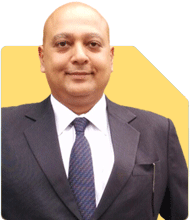Ramalingam Kalirajan |6161 Answers |Ask -Follow
Mutual Funds, Financial Planning Expert - Answered on Jul 18, 2024
He has an MBA in finance from the University of Madras and is a certified financial planner.
He is the director and chief financial planner at Holistic Investment, a Chennai-based firm that offers financial planning and wealth management advice.... more

Hi I am 36 years old. My monthly income is 80K. I am investing 10000 in PPFCF, 3000 in ICICI psu fund, 2000 in Mirae asset flexi fund & 9000 in RD monthly. My monthly expenses are 50K. I want to build a corpus of 3 Cr by the age of 45 yrs. can you pls review my investments & suggest a plan to reach my goal
Age: 36 years
Monthly Income: Rs 80,000
Monthly Expenses: Rs 50,000
Current Investments:
Parag Parikh Flexi Cap Fund (PPFCF): Rs 10,000 per month
ICICI PSU Fund: Rs 3,000 per month
Mirae Asset Flexi Cap Fund: Rs 2,000 per month
Recurring Deposit (RD): Rs 9,000 per month
Financial Goal
Goal: Build a corpus of Rs 3 Crores by the age of 45 (9 years from now)
Investment Review
Parag Parikh Flexi Cap Fund (PPFCF)
This fund is known for its good performance and diversification. Continue investing here.
ICICI PSU Fund
PSU funds are sector-specific and can be volatile. Consider reducing exposure to sector-specific funds.
Mirae Asset Flexi Cap Fund
This is another good diversified equity fund. Continue investing here.
Recurring Deposit (RD)
RDs are safe but offer lower returns. Consider redirecting this amount to higher return investments.
Suggested Investment Plan
To achieve your goal of Rs 3 Crores in 9 years, you need a focused and aggressive investment strategy. Here's a revised plan:
Increase Equity Exposure
Equity mutual funds offer higher returns over the long term. Allocate more towards diversified equity funds:
Parag Parikh Flexi Cap Fund: Increase to Rs 15,000 per month.
Mirae Asset Flexi Cap Fund: Increase to Rs 5,000 per month.
Multi Cap Fund: Start with Rs 5,000 per month.
Mid Cap Fund: Start with Rs 5,000 per month for higher growth potential.
Balanced Funds
Balanced funds or hybrid funds provide a mix of equity and debt, offering moderate returns with lower risk:
Balanced Advantage Fund: Start with Rs 5,000 per month.
Reduce Sector-Specific Exposure
ICICI PSU Fund: Reduce or stop investment in this fund. Redirect this amount to diversified or balanced funds.
Systematic Investment Plan (SIP)
SIP in Mutual Funds: Set up SIPs in the suggested funds to ensure disciplined investing.
Debt and Liquid Investments
Recurring Deposit (RD): Consider reducing RD contributions. Redirect Rs 4,000 from RD to equity funds. Keep Rs 5,000 in RD for safety and liquidity.
Emergency Fund
Maintain an emergency fund equivalent to 6 months of expenses (Rs 3 Lakhs) in a high-interest savings account or liquid fund.
Additional Investments
If possible, increase your total monthly investment to Rs 35,000. This will help you reach your goal faster.
Monitoring and Adjusting
Regular Review: Review your portfolio every 6 months. Make adjustments based on market conditions and fund performance.
Rebalancing: Rebalance your portfolio annually to maintain the desired asset allocation.
Tax Efficiency
Tax Planning: Use tax-efficient investment options to minimize tax liability. Consider ELSS funds for tax-saving under Section 80C.
Final Insights
Consistency is Key: Stay consistent with your investments. Avoid making changes based on short-term market movements.
Professional Guidance: Consult a Certified Financial Planner for personalized advice and to ensure your investment strategy aligns with your goals.
Best Regards,
K. Ramalingam, MBA, CFP,
Chief Financial Planner,
www.holisticinvestment.in
You may like to see similar questions and answers below
Omkeshwar Singh | Answer |Ask -Follow
Head, Rank MF - Answered on Nov 06, 2020
Ramalingam Kalirajan |6161 Answers |Ask -Follow
Mutual Funds, Financial Planning Expert - Answered on May 10, 2024
Ramalingam Kalirajan |6161 Answers |Ask -Follow
Mutual Funds, Financial Planning Expert - Answered on Jul 02, 2024
Ramalingam Kalirajan |6161 Answers |Ask -Follow
Mutual Funds, Financial Planning Expert - Answered on Jul 12, 2024
Ramalingam Kalirajan |6161 Answers |Ask -Follow
Mutual Funds, Financial Planning Expert - Answered on Aug 30, 2024
Ramalingam Kalirajan |6161 Answers |Ask -Follow
Mutual Funds, Financial Planning Expert - Answered on Aug 30, 2024
Ramalingam Kalirajan |6161 Answers |Ask -Follow
Mutual Funds, Financial Planning Expert - Answered on Aug 30, 2024
Ramalingam Kalirajan |6161 Answers |Ask -Follow
Mutual Funds, Financial Planning Expert - Answered on Aug 30, 2024
Sushil Sukhwani |520 Answers |Ask -Follow
Study Abroad Expert - Answered on Aug 30, 2024
Radheshyam Zanwar |692 Answers |Ask -Follow
MHT-CET, IIT-JEE, NEET-UG Expert - Answered on Aug 30, 2024
Radheshyam Zanwar |692 Answers |Ask -Follow
MHT-CET, IIT-JEE, NEET-UG Expert - Answered on Aug 30, 2024
Samraat Jadhav |1989 Answers |Ask -Follow
Stock Market Expert - Answered on Aug 30, 2024
Samraat Jadhav |1989 Answers |Ask -Follow
Stock Market Expert - Answered on Aug 30, 2024
Samraat Jadhav |1989 Answers |Ask -Follow
Stock Market Expert - Answered on Aug 30, 2024






















